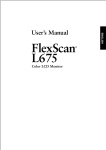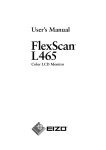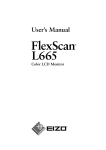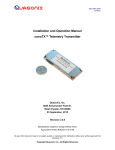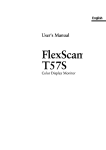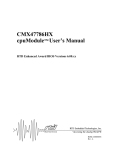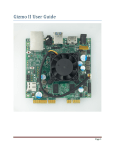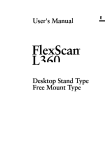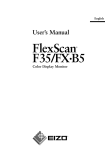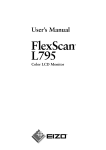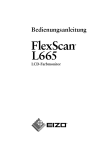Download Eizo L461 User's Manual
Transcript
ENGLISH SAFETY SYMBOLS This manual uses the safety symbols below. They denote critical information. Please read them carefully. WARNING Failure to abide by the information in a WARNING may result in serious injury and can be life threatening. CAUTION Failure to abide by the information in a CAUTION may result in moderate injury and/or property or product damage. Indicates a prohibited action. Indicates to ground for safety. Copyright© 2001 by EIZO NANAO CORPORATION. All rights reserved. No part of this manual may be reproduced, stored in a retrieval system, or transmitted, in any form or by any means, electronic, mechanical, or otherwise, without the prior written permission of Eizo Nanao Corporation. Eizo Nanao Corporation is under no obligation to hold any submitted material or information confidential unless prior arrangements are made pursuant to Eizo Nanao Corporation's receipt of said information. Although every effort has been made to ensure that this manual provides up-to-date information, please note that EIZO monitor specifications are subject to change without notice. ENERGY STAR is a U.S. registered mark. Apple and Macintosh are registered trademarks of Apple Computer, Inc. VGA is a registered trademark of International Business Machines Corporation. DPMS is a trademark and VESA is a registered trademark of Video Electronics Standards Association. Windows is a registered trademark of Microsoft Corporation. ScreenManager and PowerManager are trademarks of Eizo Nanao Corporation. FlexScan and EIZO are registered trademarks of Eizo Nanao Corporation. As an ENERGY STAR® Partner, Eizo Nanao Corporation has determined that this product meets the ENERGY STAR guidelines for energy efficiency. 2 TABLE OF CONTENTS PRECAUTIONS .............................................................................. 4 1. INTRODUCTION ............................................................................ 9 2. ENGLISH 1-1. Features ....................................................................................................... 9 1-2. Package Contents ........................................................................................ 9 1-3. Controls & Connectors ................................................................................ 10 CABLE CONNECTION ................................................................ 11 2-1. Before connecting ....................................................................................... 11 2-2. Connecting the signal cable ........................................................................ 12 3. ScreenManager ........................................................................... 14 3-1. How to use the ScreenManager .................................................................. 14 3-2. ScreenManager Adjustments and Settings ............................................... 15 3-3. Useful Functions ......................................................................................... 16 4. ADJUSTMENT ............................................................................ 18 4-1. 4-2. 4-3. 4-4. Screen Adjustment ..................................................................................... 18 Displaying the low resolutions ..................................................................... 22 Color adjustment ......................................................................................... 24 Power-save Setup ....................................................................................... 26 5. ATTACHING AN ARM STAND .................................................... 27 6. TROUBLE SHOOTING ................................................................ 29 7. CLEANING ................................................................................... 32 8. SPECIFICATIONS ....................................................................... 33 9. GLOSSARY.................................................................................. 35 10. INDEX .......................................................................................... 37 APPENDIX ............................................................................................. i TABLE OF CONTENTS 3 PRECAUTIONS IMPORTANT! ´ This product has been adjusted specifically for use in the region to which it was originally shipped. If operated outside the region to which it was originally shipped, the product may not perform as stated in the specifications. ´ To ensure personal safety and proper maintenance. Please read this section and the caution statements on the unit (refer to the figure below). [Location of the Caution Statements] CAUTION:Risk of electric shock. Do not open. ATTENTION:Risque de choc electrique. Ne pas ouvrir. ACHTUNG:Gefahr des elektrischen schlages. Rückwand nicht entfernen. The equipment must be connected to a grounded main outlet. Jordet stikkontakt skal benyttes når apparatet tilkobles datanett. Apparaten skall anslutas till jordat nätuttag. WARNING ´ If the unit begins to emit smoke, smells like something is burning, or makes strange noises, disconnect all power connections immediately and contact your dealer for advice. Attempting to use a malfunctioning unit can be dangerous. ´ Do not dismantle the cabinet or modify the unit. Dismantling the cabinet or modifying the unit may result in electric shock or burn. ´ Refer all servicing to qualified service personnel. Do not attempt to service this product yourself as opening or removing covers may expose you to dangerous voltage or other hazards. 4 PRECAUTIONS WARNING ´ Place the unit on a strong, stable surface. A unit placed on an inadequate surface may fall, resulting in injury or equipment damage. If the unit falls, disconnect the power immediately and have the unit checked by a qualified service engineer before using it again. Using a unit after it has been dropped may result in fire or electric shock. ENGLISH • Keep small objects or liquids away from the unit. Small objects accidentally falling through the ventilation slots into the cabinet or spillage into the cabinet may result in fire, electric shock, or equipment damage. If an object or liquid falls/spills into the cabinet, unplug the unit immediately. Have the unit checked by a qualified service engineer before using it again. OK ´ Set the unit in an appropriate location. Not doing so may cause damage and could result in fire or electric shock. * Do not place in outdoors. * Do not place in the transportation system (ship, aircraft, trains, automobiles, etc.) * Do not install in a dusty or humid environment. * Do not place in a location where steam can have direct contact with the screen. * Do not place near heat generating devices or a humidifier. • To avoid danger of suffocation, keep the plastic packing bags away from babies and children. • Use the enclosed power cord and connect to the standard power outlet of your country. Be sure to remain within the rated voltage of the power cord. Not doing so may cause in fire or electric shock. ´ To disconnect the power cord, grasp the plug firmly and pull. OK Never tug on the cord, doing so may cause damage and could result in fire or electric shock. ´ The equipment must be connected to a grounded main outlet. Not doing so may cause in fire or electric shock. PRECAUTIONS 5 WARNING ´ Use the correct voltage. * The unit is designed for use with a specific voltage only. Connection to another voltage than specified in this User’s Manual may cause fire, electric shock, or other damage. * Do not overload your power circuit, as this may result in fire or electric shock. * For proper connections of the power cord, be certain to plug the power cord to the provided unit connector and directly to a wall outlet. Not doing so may result in fire or electric shock. ´ Handle the power cord with care. * Do not place the cord underneath the unit or other heavy objects. * Do not pull on or tie the cord. If the power cord becomes damaged, stop using it. Use of a damaged cord may result in fire or electric shock. ´ Never touch the plug and power cord if it begins to thunder. Touching them may result in electric shock. ´ When attaching an arm stand, please refer to the user’s manual of the arm stand and install the unit securely with the enclosed screws. Not doing so may cause the unit to come unattached, which may result in injury or equipment damage. When the unit is dropped, please ask your dealer for advice. Do not continue using a damaged unit. Using a damaged unit may result in fire or electric shock. When reattaching the tilt stand, please use the same screws and tighten them securely. ´ Do not touch a damaged LCD panel directly with bare hands. The liquid crystal which leaks from the panel is poisonous if it enters the eyes or mouth. If any part of the skin or body comes in direct contact with the panel, please wash thoroughly. If some physical symptoms result, please consult your doctor. ´ Follow local regulation or laws for safe disposal. The backlight of the LCD panel contains mercury. 6 PRECAUTIONS CAUTION WARNING ENGLISH ´ Handle with care when carrying the unit. Disconnect the power cord and cables when moving the unit. Moving the unit with the cord attached is dangerous. It may result in injury or equipment damage. * When handling the unit, grip the bottom of the unit firmly with both hands ensuring the panel faces outward before lifting. OK Dropping the unit may result in injury or equipment damage. ´ Do not block the ventilation slots on the cabinet. * Do not place books or any other papers on the ventilation slots. * Do not install the unit in a closed space. * Do not use the unit laying down or upside down. Using the unit in these ways blocks the ventilation slots and prevents proper airflow, leading to fire or other damage. ´ Do not touch the plug with wet hands. Touching the plug with wet hands is dangerous and can cause electrical shock. ´ Use an easily accessible power outlet. This will ensure that you can disconnect the power quickly in case of a problem. ´ Periodically clean the area around the plug. Buildup of dust, water, or oil on the plug may result in fire. ´ Unplug the unit before cleaning it. Cleaning the unit while it is plugged into a power outlet may result in electric shock. ´ If you plan to leave the unit unused for an extended period, disconnect the power cord from the wall socket after turning off the power switch for the safety and the power conservation. PRECAUTIONS 7 Suggestions for Maximizing Comfort ´ To lessen the chance of possible injury and to increase your comfort and productivity while you operate the unit, we suggest the followings: * Avoid less favorable body positioning. Sit back on the chair with your back straight. * Adjust the height of the chair so that the both soles touch the floor. * Adjust the height of your chair, unit, or keyboard so that you can keep your wrists straight while typing. * Set the unit slightly below eye level. ´ Adjust brightness of the screen depending on the brightness of your environment. Too dark or too bright of a screen can cause eyestrain. ´ Be sure to take adequate rests. A 10-minute rest period each hour is suggested. LCD Panel ´ The screen may have defective pixels. These pixels may appear as slightly light or dark area on the screen. This is due to the characteristics of the panel itself, and not the product. ´ The backlight of the LCD panel has a fixed life span. When the screen becomes dark or begins to flicker, please contact your dealer. ´ Do not press on the panel or edge of the frame strongly, as this will result in damage to the screen. There will be prints left on the screen if the pressed image is dark or black. If pressure is repeatedly applied to the screen, it may deteriorate or damage your LCD panel. Leave the screen white to decrease the prints. ´ Do not scratch or press on the panel with any sharp objects, such as a pencil or pen as this may result in damage to the panel. Do not attempt to brush with tissues as this may scratch the LCD panel. 8 PRECAUTIONS 1. INTRODUCTION Thank you very much for choosing an EIZO Color Monitor. 1-1. Features ENGLISH • 1280 x 1024 resolution p.36) incorporated 16 inch Color LCD Monitor • DVI p.35) digital input (TMDS p.36)) compliant • Horizontal scanning frequency of 31.5 ~ 80kHz Horizontal (Digital): 31.5 ~ 64 kHz Vertical scanning frequency of 50 ~ 85 Hz (1280 x 1024 ~ 75Hz) Vertical (Digital): 60 Hz (VGA Text: 70 Hz) • Auto Adjustment compliant and original “Picture Adjustment Program” software included • ColorManagement function incorporated 1-2. Package Contents Please contact your local dealer for assistance if any of the listed items are missing or damaged. • LCD Monitor • Power Cord • Signal Cable (FD-C16) • 4 of M4 x 16 mm mounting screws • EIZO LCD Utility Disk • User’s Manual • Quick Reference • Limited Warranty • Please retain the packing materials for future transference. 1. INTRODUCTION 9 1-3. Controls & Connectors Front (1) (2) (3) (4) (5) (6) (1) ScreenManager™ AUTO Adjustment button Control Buttons Enter Button Power Switch Power Indicator*1 Indicated color Green Yellow Flashing Yellow (2 times for each) Slowly flashing Yellow Monitor’s status Power -on Power save mode Power save mode for digital Power is off (2)(3)(4)(5)(6) Rear (7) (8) (9) (10) (11) Power Connector Security Lock Slot*2 DVI-I Input Connector 4 Holes for Mounting an Arm-Stand*3 Stand (Detatchable)*3 (10) (11) (7)(8) (9) *1 *2 *3 10 Regarding the power indicator for the “Off Timer”, see page 17. Allows for connection of a security cable. This lock supports Kensington’s MicroSaver security system. For further information, please consult: Kensington Technology Group 2855 Campus Drive, San Mateo, CA 94403 USA 800-650-4242, x3348 Intl: 650-572-2700, x3348 / Fax: 650-572-9675 http://www.kensington.com The L461 can be used with an optional arm stand by removing the original stand (see page 27). 1. INTRODUCTION 2. CABLE CONNECTION 2-1. Before connecting Before connecting your monitor to the PC, change the display screen settings (resolution and frequency) in accordance with the charts below. Resolution 640 x 480 640 x 480 720 x 400 800 x 600 832 x 624 1024 x 768 1152 x 864 1152 x 870 1280 x 960 1280 x 1024 Frequency ~ 85 Hz 66.67 Hz 70 Hz ~ 85 Hz 75 Hz ~ 85 Hz 75 Hz 75 Hz 75 Hz ~ 75 Hz ENGLISH Analog Input Remarks VGA, VESA Apple Macintosh VGA Text VESA Apple Macintosh VESA VESA Apple Macintosh Apple Macintosh VESA • About Plug & Play of the monitor When your computer and display support VESA DDC, the suitable resolution and the refresh rate are set by just plugging your display into the computer without any manual settings. When your computer system supports Plug & Play, the Display Information File is not required except for installing the Color Profile. Digital Input Only the following resolutions with frequency can be displayed on this model. Resolution 640 x 480 720 x 400 800 x 600 1024 x 768 1280 x 960 1280 x 1024 Frequency 60 Hz 70 Hz 60 Hz 60 Hz 60 Hz 60 Hz Remarks VGA VGA Text VESA VESA VESA VESA 2. CABLE CONNECTION 11 2-2. Connecting the signal cable • Be sure that the power switches of both the PC and the monitor are OFF. 1. Plug the signal cable into the DVI-I connector at the rear of the monitor and the other end of the cable into the video connector on the PC. After connecting, secure the connection with the screw-in fasteners. [Analog Input] Video Output Connector D-Sub mini 15 pin ·Standard graphics board ·Macintosh G3 (Blue & White) / G4 FD-C16 (enclosed) Video Output Connector D-Sub 15 pin Macintosh Macintosh Adapter (Optional) [Digital Input] Video Output Connector DVI Digital graphics board FD-C04 (Optional) • 12 The L461 is not compatible with a Power Macintosh G4/G4 Cube ADC (Apple Display Connector). 2. CABLE CONNECTION 2. Plug the power cord into the power connector on the rear of the monitor and plug the other end of the power cord into a power outlet. ENGLISH WARNING WARNING • Use the enclosed power cord and connect to the standard power outlet of your country. Be sure to remain within the rated voltage of the power cord. Not doing so may cause in fire or electric shock. • The equipment must be connected to a grounded main outlet. Not doing so may cause in fire or electric shock. 3. Turn on the monitor’s power and then switch on the PC’s power. Whenever finished, turn off the PC and the monitor. 2. CABLE CONNECTION 13 3. ScreenManager 3-1. How to use the ScreenManager As shown on the display, the ScreenManager is used to adjust the LCD monitor. ScreenManager consists of main menus and sub menus. Adjustments are made using the Enter and Control buttons (up, down, right and left) located on the front panel. Control Buttons Enter Button Auto Adjustment Button 1. Entering the ScreenManager Push the Enter Button once to display the main menu of the ScreenManager. [ Main Menu ] 2. Making Adjustments and Settings (1) (2) (3) 3. Select the desired sub menu icon using the Control buttons and push the Enter button. The sub menu appears. Use the Control buttons to select the desired setting icon and push the Enter button. The setting menu appears. Use the Control buttons to make all required adjustments and push the Enter button to save the settings. Exiting the ScreenManager (1) To return to the main menu, select the “Return” icon or push the down button twice, followed by the Enter button. (2) To exit the ScreenManager, select “Exit” icon and push the Enter button. • Double clicking the Enter button at any time also exits the ScreenManager menu. 14 3. ScreenManager 3-2. ScreenManager Adjustments and Settings. The following table shows all the ScreenManager’s adjustment and setting menus. “*” indicates adjustments of analog input only and “**” indicates digital input only. Sub menu Clock* Phase* Position* Resolution* Smoothing Contrast/Brightness ColorRange Adjustment* Management Standard Mode Temperature Custom Mode Temperature Saturation Hue Gain Save PowerManager DVI DMPM** VESA DPMS* Others Screen Size Border Intensity Off Timer Information Language *1 ENGLISH Main menu Screen Reference 4. ADJUSTMENT(p.18) Set the monitor’s off timer to on or off. (p.17) Menu Position Adjust the menu position. Menu Off Timer Set the menu displaying time. Translucent Set the transparency of the white background for the menu. Reset Return to the factory default settings. (p.34) Information Review the ScreenManager’s settings, model name, Serial Number and usage time*1. English, German, French, Spanish, Select the ScreenManager’s Italian, Swedish and Japanese language. Due to the inspection on the factory, the usage time may not “0 hour” at shipping. 3. ScreenManager 15 3-3. Useful Functions Adjustment Lock Use the “Adjustment Lock” function to prevent any accidental changes. Locked function Unlocked function • Auto adjustment button adjustments and settings in the ScreenManager. • Adjustment of contrast and brightness by the control buttons. • To lock Press on the Auto adjustment button while switching on the monitor’s power switch on the front panel. • To unlock Switch off the monitor’s power by the power switch on the front panel, then hold down the Auto adjustment button once again and turn the power back on. EIZO Logo Disappearing function When switching on the power, the EIZO logo is displayed for a while. If you desire to undisplay this logo, use this function. • To undisplay Switch off the monitor’s power by the power switch on the front panel. Turn the power back again with pressing the enter button on the front panel. • To display again Switch off the monitor’s power by the power switch on the front panel. Turn the power back again with pressing the enter button on the front panel. 16 3. ScreenManager Off Timer [Procedure] (1) Select “Off Timer” in the ScreenManager “Others” menu. (2) Select “Enable” and press the right and left buttons to adjust the “On Period” (1 to 23 hours). [Off timer system] PC Monitor LED On Period (1H~23H) Operation Green Last 15 min. in "On period" Advance Notice *1 Green Flashing "On period" expired "Power Off" Mode Flashing yellow slowly *1 Advance notice (LED flashing green) will be given 15 minutes before the monitor automatically enters the “Power Off” mode. To delay entering the “Power Off” mode, press the power switch during the advance notice period. The monitor will continue to operate for an additional 90 minutes. Press the power switch to return to a normal screen. • The off timer function works while the PowerManager is active, but there is no advance notice before the monitor’s power is switched off. 3. ScreenManager 17 ENGLISH The off timer function causes the monitor to automatically enter a power off mode after a predetermined amount of time has lapsed. This function was created to reduce afterimage p.35) characteristics that are particular to LCD monitors when the monitor screen is left on for a long period without use. 4. ADJUSTMENT 4-1. Screen Adjustment • Allow the LCD monitor to stabilize for at least 20 minutes before making image adjustments. Screen adjustments for the LCD monitor should be used in suppressing screen flickering and also for adjusting the screen to its proper position. There is only one correct position for each display mode. When using the analog input, it is also recommended to use the ScreenManager function when first installing the display or whenever changing the system. For convenience, an easy set-up Program installed on the utility disk to assist in the set-up procedure is provided. When using the digital input, the monitor displays the digital input image correctly based on its pre-setting data. Please adjust the contrast and brightness as desired with referring page 21. 1. Push the Auto adjustment button on the front panel. The message “Your setting will be lost, if you press again now.” appears and remains on the screen for 5 seconds. While the message is on the screen, push the Auto adjustment button again to automatically adjust the clock, phase, screen position and resolution. If you do not wish to do adjust the screen, do not push the Auto adjustment button again. If the appropriate screen can not be made by using the Auto adjustment button, adjust the screen through the following procedures. 2. Install the “Screen adjustment program”. Having read the “readme.txt” file, install and run the “Screen adjustment program” in the enclosed EIZO LCD utility disk. Step by step adjustment is provided by the wizard guide. • If the user’s operating system has no utility disk (e.g. OS/2), we recommend setting the desktop pattern to that as shown in the diagram below. Every-other-dot pattern 18 4. ADJUSTMENT 3. Adjust by using “Screen” menu in the ScreenManager. (1) Vertical bars appear on the screen. Æ Use the “Clock” p.35) adjustment • When adjusting the “Clock,” the horizontal screen size will also change. (2) Horizontal flickering, blurring or bars appear on the screen. Æ Use the “Phase” p.36) adjustment. Select the “Phase” and eliminate the horizontal flickering, blurring or bars by using the right and left buttons. • Horizontal bars may not completely disappear from the screen depending on the PC. 4. ADJUSTMENT 19 ENGLISH Select the “Clock” and eliminate the vertical bars by using the right and left of the control buttons. Do not continuously press the control buttons, as the adjustment value will change quickly and make it difficult to locate the most suitable adjustment point. If the horizontal flickering, blur or bars appear, proceed to “Phase” adjustment as follows. (3) The screen position is incorrect. Æ Use the “Position” adjustment. The correct displayed position of LCD monitor is decided because the number and the position of the pixels are fixed. The “Position” adjustment moves the image to the correct position. Select “Position” and adjust the position so all the dotted line appear around screen, by using the up, down, right and left buttons. (4) Screen image is smaller or larger than the actual screen images. Æ Use the “Resolution” adjustment. Adjustment is needed when the input signal resolution and the resolution now being displayed is different. Select “Resolution” and confirm if the resolution now being displayed is the same as the input resolution. If it is not, adjust the vertical resolution using the up and down button and adjust the horizontal resolution using the right and left buttons. Smaller than the actual screen images. Adjusted to actual screen Larger than the actual screen images. 20 4. ADJUSTMENT 4. To set the Output signal range (Dynamic Range) of the signal. Æ Use the “Range Adjustment”.p.36) [Auto] Push the Auto adjustment button on the front panel while displaying the “Range adjustment” menu to automatically adjust the range. The screen blanks for a moment, and adjusts the color range to display the whole color gradation of the current output signal. • Pressing Auto adjustment button while displaying the contrast/brightness adjustment screen (appeared by pressing the control buttons directly) adjusts the range automatically. 5. To set the Contrast of the screen. Æ Use the “Contrast” adjustment. This controls the brightness for the each color (red, blue and green) at a same time. Select “Contrast/Brightness” in the screen menu and adjust by using the right and left buttons. 6. To set the Brightness of the screen. Æ Use the “Brightness” adjustment. This controls the brightness for the entire screen. The brightness of the entire screen is controlled by changing the brightness if the backlight. Select “Contrast/Brightness” in the screen menu and adjust by using the up and down buttons. • Directly pressing the control buttons also adjusts the contrast and brightness. Press the “Enter” button to save and exit the settings after the adjustment. 4. ADJUSTMENT 21 ENGLISH This controls the level of output signal range to display the whole color gradation (256 colors). Select the “Range Adjustment” in the “ColorManagement” menu. 4-2. Displaying the low resolutions The lower resolutions are enlarged to full screen automatically. Using the “ScreenSize” function in the “Others” menu enables to change the screen size. 1. To enlarge the screen size when displaying a low resolution. Æ Select “Screen Size” Select the “Screen Size” in the others menu and select the screen size by using the up and down buttons. • Full • Enlarged • Normal Displays the picture on the screen in full, irrespective of the picture’s resolution. Since the vertical resolution and the horizontal resolution are enlarged at different rates, some images may appear distorted. Displays the picture on the screen in full, irrespective of the picture’s resolution. Since the vertical resolution and horizontal resolution are enlarged at same rates, some horizontal or vertical image may disappear. Displays the picture at the actual Screen resolution. Example: Displaying 1024 x 768 Enlarged Full 1280 x 1024 22 4. ADJUSTMENT 1280 x 960 Normal 1024 x 768 2. To be clear-cut the letters or lines of the enlarged screen. Æ Switch the “Smoothing” setting. • “Smoothing” is disabled in the following cases. * 1280 x 1024 of resolution * “Enlarged” mode in “Screen Size” setting with the 1280 of the horizontal resolution (i.e. 1280 x 960) * “Normal” mode in the “Screen Size” setting 3. To set the brightness of the black area surrounding the image. Æ Set the “Border Intensity” In the “Normal” mode, the outer area (border) is usually black. Select “Border Intensity” in the others menu and adjust by using the right and left buttons. Border 4. ADJUSTMENT 23 ENGLISH Select “Smoothing” in the screen menu and switch the setting to “Off” by using the left button. 4-3. Color Adjustment The “ColorManagement”menu in the ScreenManager enables to change the color of the screen. Before the Color adjustment • Allow the LCD monitor to stabilize for at least 20 minutes before making color adjustments. • After finishing each adjustment in the custom mode, select “Save” icon to resister the adjustment. Otherwise, the adjustment will be lost. • The adjustment values represent the current level within the specific adjustment only. They are available only as a reference tool. (To create a uniform white or black screen, the percentages for each will probably not be the same.) • In the analog input, perform the “Range Adjustment” (p.21) before making the color adjustments . The gradation pattern like below is recommended for the “Range Adjustment”. 1. To change the color tone of the white. Æ Set the “Temperature”.p.35) The “Temperature” can be set from 4,000 K to 10,000 K , in 500 K increments (including 9,300 K). The default setting is “OFF”. To resister the adjustment in the custom mode, select the “Save” icon and then push the enter button. • Setting the temperature under 4,000 K or over 10,000 K invalidates the color temperature setting. (The color temperature’s setting turns “OFF”.) • Adjusting the “Gain” (p. 25) invalidates the color temperature setting. (The color temperature’s setting turns “OFF”.) 24 4. ADJUSTMENT 2. To change the saturation. Æ Use the “Saturation” adjustment. • The “Saturation” adjustment may cause undisplayable color tone. 3. To change the flesh color, etc. Æ Use the “Hue” adjustment. The “Hue” can be selected from -16 to 16. To register the adjustment, select the “Save” icon and then push the enter button. • The “Hue” adjustment may cause undisplayable color tone. 4. To adjust each color (red, green and blue). Æ Use the “Gain”p.35) adjustment. By adjusting the red, green and blue color tones for each mode, custom colors can be defined. The 100 % indicates unadjusted condition. Display a white or gray background image and adjust the “Gain”. To register the adjustment, select the “Save” icon and then push the Enter button. • The “Gain” adjustment may cause undisplayable color tone. • Adjusting the “Gain” invalidates the color temperature setting. (The color temperature’s setting turns “OFF”. ) 4. ADJUSTMENT 25 ENGLISH The “Saturation” can be selected from -64 to 64. Setting the minimum level (-64) turns the image to the monochrome. To register the adjustment, select the “Save” icon and then push the enter button. 4-4. Power-save Setup • Do your part to conserve energy, turn off the monitor when you are finished using it. Disconnecting the monitor from the power supply is recommended to save energy completely. Analog Input This monitor complies with the VESA DPMS p.36) standard. 1. 2. Set the PC’s power saving settings. Select “VESA DPMS” in the “PowerManager” menu. [Power saving system] PC Monitor LED On Operation Green Power saving Yellow Power saving mode STAND-BY SUSPEND OFF Operate the mouse or keyboard to return to a normal screen. Digital Input This monitor complies with the DVI DMPM p.35). 1. Set the PC’s power saving settings. 2. Select “DVI DMPM” in the “PowerManager” menu. [Power saving system] PC Monitor LED On Operation Green Power saving Power saving Yellow Off mode Power saving*1 Flashing yellow (2 times for each) Operate the mouse or keyboard to return to a normal screen from the Power save mode of the PC. Power on the PC to return a normal screen from the Off mode of the PC. 26 4. ADJUSTMENT 5. ATTACHING AN ARM STAND The L461 can be used with an arm stand by removing the tilt stand and attaching the arm stand to the terminal. ENGLISH ´ Use an arm stand that satisfies the followings. • When using the L461 with an arm stand, the arm stand must be VESA approved : * Use an arm stand with a 75 mm x 75 mm hole spacing on the arm mounting pad. * Use an arm stand that is able to support an object weighting 8.0 kg. ´ TÜV/GS approved arm stand. ´ Use an arm stand with sufficient stability (mechanical firmness) to support the weight of the monitor. ´ Use an arm stand remaining that position where it is manually moved. ´ Use an arm stand with the ability to tilt the monitor forward and backward. ´ Please connect cables after attaching an arm stand. M4 x 16 mm 75 mm 75 mm Setup Procedure 1. Lay the L461 down as shown below. Do not scratch the panel. Soft Cloth or Cushion 2. Remove the tilt stand by loosening the screws (2 pcs of M4 x 10 mm). 5. ATTACHING AN ARM STAND 27 3. Attach an arm stand to the L461 securely. WARNING WARNING ´ When attaching an arm stand, please refer to the user’s manual of the arm stand and install the unit securely with the enclosed screws. Not doing so may cause the unit to come unattached, which may result in injury or equipment damage. When the unit is dropped, please ask your dealer for advice. Do not continue using a damaged monitor. Using a damaged monitor may result in fire or electric shock. When reattaching the tilt stand, please use the same screws and tighten them securely. 4 Mounting Screws (enclosed): M4 x 16 (mm) Arm-stand For the Portrait display, rotate the monitor clockwise and use the software for the portrait. 28 5. ATTACHING AN ARM STAND 6. TROUBLESHOOTING Problems 1. No picture • Indicator status: Off • Indicator status: Green • Indicator status: Yellow • Indicator status: Slowly flashing Yellow 2. Following messages appear. (Error messages will remain on the screen for 40 seconds.) •Whenever an error signal message appears, the signal frequency will be displayed in red. (Example) Points to check with possible solutions Check that the power cord is correctly connected. If the problem persists, turn off the monitor power for a few minutes, then turn it back on and try again. Check the “Contrast and Brightness” settings. Minimum settings will cause screen to be blank. Try pressing a key on the keyboard, or clicking the mouse. (p.26) Try pressing the power switch. These messages appear when the signal is not inputted correctly, even if the monitor functions properly. When the image is displayed correctly after a short time, there is no problem with the monitor. (Some PCs do not output the signal soon after powering on.) Check that the PC is turned ON. Check that the signal cable is properly connected to the PC or graphics board. Use the graphics board’s utility software to change the frequency setting. (Refer to the manual of the graphics board.) 6. TROUBLESHOOTING 29 ENGLISH If a problem persists even after applying the suggested remedies, contact an EIZO dealer. No picture problems Æ See No.1 ~ No.2 Imaging problems ÆSee No.3 ~ No.11 Other problemsÆSee No.12 ~ No.16 Problems Points to check with possible solutions 3. Display position is incorrect. Adjust the image position using the “Position”. (p.20) If the problem persists, use the graphics board’s utility software to change the display position if available. 4. Screen image is smaller or larger than the actual screen images. Adjust the resolution using the “Resolution”. (p.20) 5. Vertical bars of distortion appear. Decrease the vertical bars using the “Clock”. (p.19) 6. Horizontal bars of distortion appear. Decrease the horizontal bars using the “Phase’. (p.19) 7. Letters and lines appear blurred. Switch the “Smoothing” mode to “Off”. (p.23) 8. The screen is too bright or too dark. Adjust the “contrast and brightness”. (The backlight of the LCD monitor has a fixed life span. When the screen becomes dark or begins to flicker, please contact your dealer.) 9. Afterimages appear. When the screen image is changed after displaying the same image for a long period, an afterimage may appear. Use the “Off Timer” function and avoid keeping the screen on all the time. (p.17) 10. The screen has defective pixels (e.g. slightly light or dark). This is due to the characteristics of the panel itself, and not the LCD product. 30 6. TROUBLESHOOTING Problems Points to check with possible solutions Leaving the screen white may solve the problem. 12. The “Smoothing” can not be selected. “Smoothing” is disabled in the following cases. • 1280 x 1024 of resolution • “Enlarged” mode in the “Screen Size” setting with the 1280 of horizontal resolution (i.e. 1280 x 960) • “Normal” mode in the “Screen Size” setting. 13. The utility disk is unable to be opened (for Macintosh only). Some Macintosh without PC-Exchange do not allow the utility disk to be opened. Please set the desktop pattern to every-other-dot before adjustment. (p.18) 14. • The Enter button does not operate. • The Auto adjustment button does not operate. The adjustment lock is probably on. To unlock: switch the LCD monitor off. Then, while pressing the Auto adjustment button, switch the power on. (p.16) 15. The Auto adjustment button does not work properly. The Auto sizing function is intended for use on the Macintosh and on AT-compatible PC running Windows. It may not work properly in either of the following cases. When running an AT-compatible PC on MS-DOS (Not windows). The background color for the “wall paper” or “desktop” pattern is set to black. Some signals from a graphics board may not function properly. 16. Frequency does not change after installing “Monitor information file” in the attached utility disk on Windows 95/98/Me/2000. Use the graphics board’s utility software to change the input signal frequency. 6. TROUBLESHOOTING ENGLISH 11. Fingerprints remain on the screen. 31 7. CLEANING Periodic cleaning is recommended to keep the monitor looking new and to prolong its operation lifetime. • Never use thinner, benzene, alcohol (ethanol, methanol, or isopropyl alcohol), abrasive cleaners, or other strong solvents, as these may cause damage to the cabinet or LCD panel. Cabinet To remove stains, wipe the cabinet with a soft, lightly moistened cloth using a mild detergent. Do not spray wax or cleaner directly onto the cabinet. LCD Panel The LCD surface can be cleaned with a soft cloth, such as cotton or lens paper. If necessary, stubborn stains can be removed by moistening part of a cloth with water to enhance its cleaning power. 32 7. CLEANING 8. SPECIFICATIONS LCD Panel Dot Pitch Scan Frequency Resolution Dot Clock (Max) Display Colors Display Area Power Supply Power Consumption Input Connector Input Signal Analog Digital Signal registration Plug & Play Dimensions Dimensions (without stand) Weight Weight(without stand) Temperature Humidity 1280 dots x 1024 lines 135 MHz 108 MHz(Digital) 16 milion colors (max) 317.4 mm (H) x 253.9 mm (V) (12.5” (H) x 10.0” (V)) (Viewable image size: 406 mm (16.0”)) 100-120/200-240 VAC±10%, 50/60 Hz, 0.7 A/0.4 A Normal: 40 W Power Saving Mode: Less than 3 W DVI-I x 1 Sync Separate, TTL, Positive/Negative Video : 0.7 Vp-p/75 Ω, Positive TMDS (Single Link) 35 (Analog Factory Preset: 21) VESA DDC 2B 384 mm (W) x 387.2 mm (H) x 171.4 mm (D) (15.1” (W) x 15.0” (H) x 6.7” (D)) 384 mm (W) x 325 mm (H) x 69 mm (D) (15.1” (W) x 12.8” (H) x 2.7”(D)) 5.7 kg (12.6 lbs.) 4.3 kg (9.5 lbs.) Operating: 0°C to 35°C (32°F to 95°F) Storage: -20°C to 60°C (-4°F to 140°F) 30% to 80% R.H. Non-condensing 8. SPECIFICATIONS 33 ENGLISH 41 cm (16.0 inch), TFT color LCD Panel with AntiGlare Hard Coating Viewing Angle: Horizontal: 130º, Vertical: 160º (at Contrast Ratio > 5) 0.248 mm Horizontal: 31.5kHz - 80 kHz (Automatic) Vertical: 50 Hz-85 Hz (Automatic) (1280 x 1024: up to 75 Hz) Horizontal (Digital): 31.5kHz - 64 kHz Vertical (Digital): 60Hz (VGA text: 70Hz) Dimensions 384 (15.1) 319.2 (12.6) 25° 3° 62.2(2.4) 172.8(6.8) 255.8(10.1) 325(12.8) 387.2(15.2) 36.8(1.4) 69(2.7) 167.5(6.6) 171.4(6.7) FRONT SIDE Default Settings Default Settings are as follows: ScreenManager menu Default Settings Contrast 100% Brightness 100% Smoothing On Color Mode Standard Temperature Off PowerManager VESA DPMS DVI DMPM(Digital Input) Screen Size Full Screen Off Timer Disable Menu Off Timer 45 seconds Language English 34 8. SPECIFICATIONS 170(6.7) REAR 9. GLOSSARY Afterimage The Afterimage is particular to LCD monitors when the monitor screen is left on for a long period without use. The “Afterimage” can be removed gradually by changing the displayed image. With the analog input signal display, the analog signal is converted to a digital signal by the LCD circuitry. To convert the signal correctly, the LCD monitor needs to produce the same number clock pulse as the dot clock of the graphics system. When the clock pulse is not correctly set, some vertical bars of distortion are displayed on the screen. Color Temperature (Temperature) Color Temperature is a method to measure the white color tone, generally indicated in degrees Kelvin. At high temperatures the white tone appears somewhat blue, while at lower temperatures it appears somewhat red. Computer monitors generally give best perfoemance at high temerature settings. 5000K: Slightly reddish white. 6500K: Warm-white tone, similar to white papaer or daylight. 9,300K: Slightly bluish white. DVI (Digital Visual Interface) A digital flat panel interface. DVI can transmit digital data from the PC directly without loss with the signal transition method “TMDS”. There are two kinds of DVI connectors. One is DVI-D connector for digital signal input only. The other is DVI-I connector for both digital and analog signal inputs. DVI-DMPM (DVI Digital Monitor Power Management) The Power management system for the digital interface. The “Monitor ON” status (operation mode) and the “Active Off” status (power-saving mode) are indispensable for the DVI-DMPM as the monitor’s power mode. Gain Adjustment Adjusts each color parameter for red, green and blue. The color of the LCD monitor is displayed through the color filter of the LCD panel. Red, green and blue are the three primary colors. The colors on the monitor are displayed by combining these three colors. The color tone can change by adjusting the illumination amount passed through each color’s filter. 9. GLOSSARY 35 ENGLISH Clock Phase The phase adjustment decides the sampling timing point for converting the analog input signal to a digital signal. Adjusting the phase after the clock adjustment will produce a clear screen. Range Adjustment The Range Adjustment controls the level of output signal range to display the whole color gradation. Resolution The LCD panel consists of a fixed number of pixel elements which are illuminated to form the screen image. The EIZO L461 consists of 1280 horizontal pixels and 1024 vertical pixels. At a resolution of 1280 X 1024, all pixels are used and the image is displayed as a full screen. At the lower display modes of 640 x 480 or 800 x 600, the images are displayed in the center of the screen using a smaller portion if the pixels. TMDS (Transition Minimized Differential Signaling) A signal transition method for the digital interface. VESA DPMS The acronym VESA stands for “Video Electronics Standards Association,” and DPMS stands for “Display Power Management Signaling.” DPMS is a communication standard that PCs and graphics boards use to implement power savings on the monitor side. 36 9. GLOSSARY 10.INDEX A O Off timer ------------------------------- 15, 17 Others -------------------------------------- 19 P Package Contents ------------------------ 9 Phase ----------------------------- 15, 19, 36 Pin Assignment ---------------------------- i Position -------------------------------- 15, 20 Power consumption --------------------- 33 Power Indicator ----------------- 10, 17, 26 PowerManager ----------------------- 15, 26 Power-save Setup ----------------------- 26 PRECAUTIONS --------------------------- 4 Preset Timing Chart ----------------------- i B Before connecting ----------------------- 11 Border Intensity --------------------- 15, 23 Brightness ---------------------------- 15, 21 C CABLE CONNECTION ----------------- 11 CLEANING -------------------------------- 32 Clock ------------------------------ 15, 19, 35 Color Adjustment ------------------------- 24 ColorManagement ------------- 15, 21, 24 Contrast ------------------------------- 15, 21 Controls & Connectors ------------------ 10 Custom Mode ----------------------------- 15 D ENGLISH ADJUSTMENT --------------------------- 18 Adjustment Lock ------------------------- 16 Afterimage ----------------------------- 17,35 ATTACHING AN ARM STAND -------- 27 R Range Adjustment ------------- 15, 21, 24 Reset --------------------------------------- 15 Resolution ---------- 9, 11, 15, 24, 33, 36 S Default setting ---------------------------- 34 Dimensions -------------------------------- 34 Displaying the low resolutions -------- 22 DVI --------------------------------------- 9, 35 DVI-DMPM ---------------------- 15, 26, 35 Saturation ----------------------------- 15, 25 Save ----------------------------------- 15, 24 Screen --------------------------------- 15, 19 Screen Adjustment ---------------------- 18 Screen Size -------------------------- 15, 22 ScreenManager ---------------------- 15, 26 ScreenManager Adjustments and Settings ----- 15 Security Lock Slot ----------------------- 10 Smoothing ---------------------------- 15, 24 SPECIFICATIONS ----------------------- 33 E EIZO LCD utility disk ---------------- 9, 18 EIZO Logo Disappearing function ---- 16 G Gain ------------------------------- 15, 25, 35 GLOSSARY ------------------------------- 35 H T Temperature --------------------- 15, 24, 36 TMDS ------------------------------------ 9, 36 Translucent -------------------------------- 15 TROUBLE SHOOTING ----------------- 29 How to use the ScreenManager ------ 14 Hue ------------------------------------- 15, 25 I Information -------------------------------- 15 V VESA DPMS -------------------- 15, 26, 36 L Language ---------------------------------- 15 M Menu Off Timer --------------------------- 15 Menu Position ----------------------------- 15 10. INDEX 37 MEMO 38 10. INDEX APPENDIX / ANHANG / ANNEXE Pin Assignment Pin-Belegung Affectation des Broches * DVI-I Connector 1 2 3 4 5 6 7 Pin No. 8 C1 C2 C3 C4 C5 1 Signal TMDS Data2- 9 10 11 12 13 14 15 16 17 18 19 20 21 22 23 24 2 Pin No. TMDS Data1/3 11 21 Shield TMDS Data2+ 12 TMDS Data2/4 3 13 Shield 4 NC* 14 5 NC Pin No. Signal Signal NC TMDS Clock Shield NC 22 NC 23 TMDS Clock+ +5V Power 24 TMDS ClockGround (return 15 for +5V, Hsync C1 Analog Red and Vsync) DDC Clock 16 Hot Plug Detect C2 Analog Green (SCL) 7 DDC Data (SDA) 17 TMDS Data0- C3 Analog Blue Analog Analog 18 TMDS Data0+ C4 8 Vertical Sync Horizontal Sync Analog Ground TMDS Data0/5 C5 (analog R,G,&B 9 TMDS Data1- 19 Sheild return) 10 TMDS Data1+ 20 NC 6 (*NC: No Connection) Preset Timing Chart for Analog input Timing-Übersichten für Analog Eingang Synchronisation des Signaux pour Analog numerique Based on the signal diagram shown below 21 factory presets have been registered in the monitor's microprocessor. Der integrierte Mikroprozessor des Monitors unterstützt 21 werkseitige Standardeinstellungen (siehe hierzu die nachfolgenden Diagramme). 21 signaux ont été enregistrés en usine dans le microprocesseur du moniteur, conformément au diagramme de synchronisation ci-dessous. Front Porch Vordere Schwarzschulter Front avant B Sync Period Synchronimpuls Délai de synchronisation C Back Porch Hintere Schwarzschulter Front arrière D Blanking Period Austastzeit Délai de clignotement E Display period Display-Zeit Délai d'affichage F Total cycle Kompletter Zyklus Cycle total H Sync signal level Sync-Signalpegel Niveau du signal de synchronisation V Video signal level Video-Signalpegel Niveau du signal vidéo APPENDIX A APPENDIX i Mode ii APPENDIX Dot Clock Frequencies A: Front Porch B: Sync Period H µs/ Dot V ms/ Line H µs/ Dot V ms/ Line MHz H kHz V Hz VGA 640 x 480 25.175 31.468 59.941 0.636/ 16 0.318/ 10 3.813/ 96 0.054/ 2 VGA 720 x 400 28.322 31.468 70.087 0.636/ 18 0.381/ 12 3.813/ 108 0.064/ 2 Macintosh 640 x 480 30.24 35.00 66.67 2.116/ 64 0.086/ 3 2.116/ 64 0.086/ 3 Macintosh 832 x 624 57.28 49.73 74.55 0.559/ 32 0.020/ 1 1.117/ 64 0.060/ 3 Macintosh 1152 x 870 100.0 68.68 75.06 0.320/ 32 0.044/ 3 1.280/ 128 0.044/ 3 Macintosh 1280 x 960 126.2 74.763 74.763 0.190/ 24 0.013/ 1 1.204/ 152 0.040/ 3 VESA 640 x 480 31.5 37.86 72.81 0.508/ 24 0.026/ 9 1.270/ 40 0.079/ 3 VESA 640 x 480 31.5 37.5 75.00 0.508/ 16 0.027/ 1 2.032/ 67 0.080/ 3 VESA 640 x 480 36.0 43.27 85.01 1.556/ 56 0.023/ 1 1.556/ 56 0.069/ 3 VESA 800 x 600 36.0 35.16 56.25 0.667/ 24 0.028/ 1 2.000/ 72 0.057/ 2 VESA 800 x 600 40.0 37.88 60.32 1.000/ 40 0.026/ 1 3.200/ 128 0.106/ 4 VESA 800 x 600 50.0 48.08 72.19 1.120/ 56 0.770/ 37 2.400/ 120 0.125/ 6 VESA 800 x 600 49.5 46.88 75.00 0.323/ 16 0.021/ 1 1.616/ 80 0.064/ 3 VESA 800 x 600 56.25 53.674 85.061 0.569/ 32 0.019/ 1 1.138/ 64 0.056/ 3 VESA 1024 x 768 65.0 48.36 60.00 0.369/ 24 0.062/ 3 2.092/ 136 0.124/ 6 VESA 1024 x 768 75.0 56.48 70.07 0.320/ 24 0.053/ 3 1.813/ 136 0.106/ 6 VESA 1024 x 768 78.75 60.02 75.03 0.203/ 16 0.017/ 1 1.219/ 96 0.050/ 3 VESA 1024 x 768 94.5 68.68 85.0 0.508/ 48 0.015/ 1 1.016/ 96 0.044/ 3 VESA 1152 x 864 108.0 67.50 75.00 0.593/ 64 0.015/ 1 1.185/ 128 0.044/ 3 VESA 1280 x 1024 108.0 63.98 60.02 0.444/ 48 0.016/ 1 1.037/ 112 0.047/ 3 VESA 1280 x 1024 135.0 79.97 75.02 0.119/ 16 0.013/ 1 1.067/ 144 0.038/ 3 C: Back Porch D: Blanking Period E:Display Period F:Total Cycle V ms/ Line H µs/ Dot V ms/ Line H µs/ Dot V ms/ Line H µs/ Dot V ms/ Line 1.907/ 48 1.048/ 33 6.356/ 160 1.430/ 45 25.442/ 640 15.254/ 480 31.778/ 800 16.683/ 525 1.907/ 54 1.111/ 35 6.356/ 180 1.556/ 49 25.422/ 720 12.712/ 400 31.778/ 900 14.267/ 449 3.175/ 96 1.114/ 39 7.407/ 224 1.286/ 45 21.164/ 640 13.714/ 480 28.571/ 864 15.000/ 525 3.911/ 224 0.784/ 39 5.586/ 320 0.865/ 43 14.524/ 832 12.549/ 624 20.111/ 1152 13.414/ 667 1.440/ 144 0.568/ 39 3.040/ 304 0.655/ 45 11.250/ 1152 12.667/ 870 14.560/ 1456 13.322/ 915 1.838/ 232 0.482/ 36 3.233/ 408 0.535/ 40 10.143/ 1280 12.841/ 960 13.376/ 1688 13.376/ 1000 3.810/ 128 0.528/ 28 5.587/ 192 0.634/ 40 20.317/ 640 12.678/ 480 26.413/ 832 13.735/ 520 3.810/ 120 0.427/ 16 6.349/ 200 0.533/ 20 20.317/ 640 12.800/ 480 26.667/ 840 13.333/ 500 2.222/ 80 0.578/ 25 5.333/ 192 0.670/ 29 17.778/ 640 11.093/ 480 23.111/ 832 11.764/ 509 3.556/ 128 0.626/ 22 6.222/ 224 0.711/ 25 22.222/ 800 17.067/ 600 28.444/ 1024 17.778/ 625 2.200/ 88 0.607/ 23 6.400/ 256 0.739/ 28 20.000/ 800 15.840/ 600 26.400/ 1056 16.579/ 628 1.280/ 64 0.478/ 23 4.800/ 240 1.373/ 66 16.000/ 800 12.480/ 600 20.800/ 1040 13.853/ 666 3.232/ 160 0.448/ 21 5.172/ 256 0.533/ 25 16.162/ 800 12.800/ 600 21.333/ 1056 13.333/ 625 2.702/ 152 0.503/ 27 4.409/ 248 0.578/ 31 14.222/ 800 11.179/ 600 18.631/ 1048 11.756/ 631 2.462/ 160 0.600/ 29 4.923/ 320 0.786/ 38 15.754/ 1024 15.880/ 768 20.677/ 1344 16.666/ 806 19.20/ 144 0.513/ 29 4.053/ 304 0.673/ 38 13.653/ 1024 16.599/ 768 17.707/ 1328 14.272/ 806 2.235/ 176 0.466/ 28 3.657/ 288 0.533/ 32 13.003/ 1024 12.795/ 768 16.660/ 1312 13.328/ 800 2.201/ 208 0.524/ 36 3.725/ 352 0.582/ 40 10.836/ 1024 11.183/ 768 14.561/ 1376 11.765/ 808 2.370/ 256 0.474/ 32 4.148/ 448 0.553/ 36 10.667/ 1152 12.800 864 14.815/ 1600 13.333/ 900 2.296/ 248 0.594/ 38 3.778/ 408 0.656/ 42 11.852/ 1280 16.005 1024 15.630/ 1688 16.661/ 1066 1.837/ 248 0.475/ 38 3.022/ 408 0.525/ 42 9.481/ 1280 12.804/ 1024 12.504/ 1688 13.329/ 1066 APPENDIX H µs/ Dot APPENDIX iii MEMO iv APPENDIX [Applicable to gray (standard color version only).] Congratulations! You have just purchased a TCO’99 approved and labelled product! Your choice has provided you with a product developed for professional use. Your purchase has also contributed to reducing the burden on the environment and also to the further development of environmentally adapted electronics products. Why do we have environmentally labelled computers? In many countries, environmental labelling has become an established method for encouraging the adaptation of goods and services to the environment. The main problem, as far as computers and other electronics equipment are concerned, is that environmentally harmful substances are used both in the products and during their manufacture. Since it is not so far possible to satisfactorily recycle the majority of electronics equipment, most of these potentially damaging substances sooner or later enter nature. There are also other characteristics of a computer, such as energy consumption levels, that are important from the viewpoints of both the work (internal) and natural (external) environments. Since all methods of electricity generation have a negative effect on the environment (e.g. acidic and climate-influencing emissions, radioactive waste), it is vital to save energy. Electronics equipment in offices is often left running continuously and thereby consumes a lot of energy. What does labelling involve? This product meets the requirements for the TCO’99 scheme which provides for international and environmental labelling of personal computers. The labelling scheme was developed as a joint effort by the TCO (The Swedish Confederation of Professional Employees), Svenska Naturskyddsforeningen (The Swedish Society for Nature Conservation) and Statens Energimyndighet (The Swedish National Energy Administration). Approval requirements cover a wide range of issues: environment, ergonomics, usability, emission of electric and magnetic fields, energy consumption and electrical and fire safety. The environmental demands impose restrictions on the presence and use of heavy metals, brominated and chlorinated flame retardants, CFCs (freons) and chlorinated solvents, among other things. The product must be prepared for recycling and the manufacturer is obliged to have an environmental policy which must be adhered to in each country where the company implements its operational policy. The energy requirements include a demand that the computer and/or display, after a certain period of inactivity, shall reduce its power consumption to a lower level in one or more stages. The length of time to reactivate the computer shall be reasonable for the user. Labelled products must meet strict environmental demands, for example, in respect of the reduction of electric and magnetic fields, physical and visual ergonomics and good usability. Below you will find a brief summary of the environmental requirements met by this product. The complete environmental criteria document may be ordered from: TCO Development SE-114 94 Stockholm, Sweden Fax: +46 8 782 92 07 Email (Internet): [email protected] Current information regarding TCO’99 approved and labelled products may also be obtained via the Internet, using the address: http://www.tco-info.com/ [Applicable to gray (standard color version only).] Environmental requirements Flame retardants Flame retardants are present in printed circuit boards, cables, wires, casings and housings. Their purpose is to prevent, or at least to delay the spread of fire. Up to 30% of the plastic in a computer casing can consist of flame retardant substances. Most flame retardants contain bromine or chloride, and those flame retardants are chemically related to another group of environmental toxins, PCBs. Both the flame retardants containing bromine or chloride and the PCBs are suspected of giving rise to severe health effects, including reproductive damage in fish-eating birds and mammals, due to the bio-accumulative* processes. Flame retardants have been found in human blood and researchers fear that disturbances in foetus development may occur. The relevant TCO’99 demand requires that plastic components weighing more than 25 grams must not contain flame retardants with organically bound bromine or chlorine. Flame retardants are allowed in the printed circuit boards since no substitutes are available. Cadmium** Cadmium is present in rechargeable batteries and in the colour-generating layers of certain computer displays. Cadmium damages the nervous system and is toxic in high doses. The relevant TCO’99 requirement states that batteries, the colour-generating layers of display screens and the electrical or electronics components must not contain any cadmium. Mercury** Mercury is sometimes found in batteries, relays and switches. It damages the nervous system and is toxic in high doses. The relevant TCO’99 requirement states that batteries may not contain any mercury. It also demands that mercury is not present in any of the electrical or electronics components associated with the labelled unit. CFCs (freons) The relevant TCO’99 requirement states that neither CFCs nor HCFCs may be used during the manufacture and assembly of the product. CFCs (freons) are sometimes used for washing printed circuit boards. CFCs break down ozone and thereby damage the ozone layer in the stratosphere, causing increased reception on earth of ultraviolet light with e.g. increased risks of skin cancer (malignant melanoma) as a consequence. Lead** Lead can be found in picture tubes, display screens, solders and capacitors. Lead damages the nervous system and in higher doses, causes lead poisoning. The relevant TCO’99 requirement permits the inclusion of lead since no replacement has yet been developed. * Bio-accumulative is defined as substances which accumulate within living organisms. ** Lead, Cadmium and Mercury are heavy metals which are Bio-accumulative. For U.S.A, Canada, etc. (rated 100-120 Vac) Only FCC Declaration of Conformity We, the Responsible Party EIZO NANAO TECHNOLOGIES INC. 5710 Warland Drive, Cypress, CA 90630 Phone: 562 431 5011 declare that the product Trade name: EIZO Model: FlexScan L461 is in conformity with Part 15 of the FCC Rules. Operation of this product is subject to the following two conditions: (1) this device may not cause harmful interference, and (2) this device must accept any interference received, including interference that may cause undesired operation. This equipment has been tested and found to comply with the limits for a Class B digital device, pursuant to Part 15 of the FCC Rules. These limits are designed to provid reasonable protection against harmful interference in a residential installation. This equipment generates, uses, and can radiate radio frequency energy and, if not installed and used in accordance with the instructions, may cause harmful interference to radio communications. However, there is no guarantee that interference will not occur in a particular installation. If this equipment does cause harmful interference to radio or television reception, which can be determined by turning the equipment off and on, the user is encouraged to try to correct the interference by one or more of the following measures. *Reorient or relocate the receiving antenna. *Increase the separation between the equipment and receiver. *Connect the equipment into an outlet on a circuit different from that to which the receiver is connected. *Consult the dealer or an experienced radio/TV technician for help. Changes or modifications not expressly approved by the party responsible for compliance could void the user’s authority to operate the equipment. Note Use the attached specified cable below or EIZO signal cable with this monitor so as to keep interference within the limits of a Class B digital device. -AC Cord -Shielded Signal Cable (enclosed) Canadian Notice This Class B digital apparatus complies with Canadian ICES-003. Cet appareil numérique de le classe B est comforme à la norme NMB-003 du Canada.













































